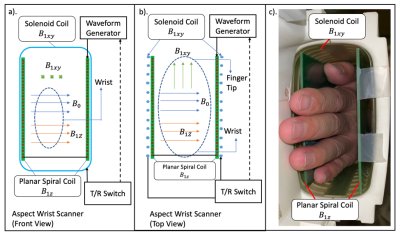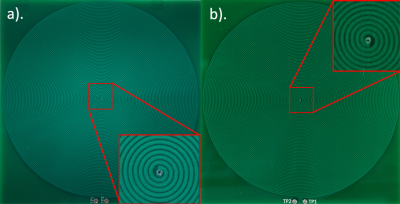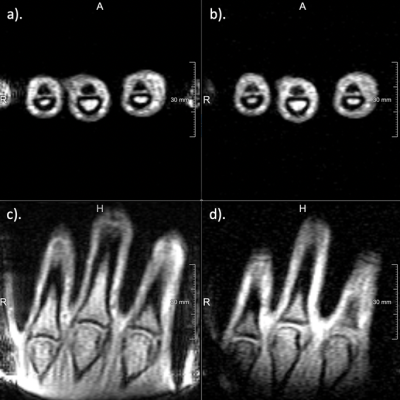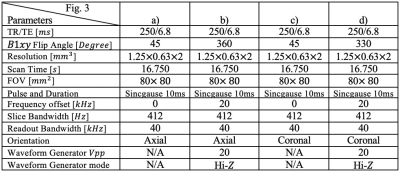1257
In vivo Two-photon Magnetic Resonance Imaging of Human Hand at 1T1Electrical Engineering and Computer Sciences, University of California, Berkeley, Berkeley, CA, United States, 2Helen Wills Neuroscience Institute, University of California, Berkeley, Berkeley, CA, United States
Synopsis
We demonstrate the first in vivo imaging experiment with a multiphoton excitation technique at 1T. To produce multiphoton excitation, we built a secondary RF coil that produces an RF field, parallel to the $$$B_{0}$$$ field. Designed for kHz frequencies, this coil consists with two layers of traces in a spiral configuration on a printed circuit board (PCB). Adding this low-frequency coil to an Aspect 1T Wrist Scanner, we acquired gradient echo images with two-photon excitation of a human hand in vivo.
Introduction
Multiphoton excitation has been used for many applications, especially in microscopy. In MRI, however, the concept is relatively unknown. Some, however, may know it as sideband excitation1. With a constant z-photon frequency, it turns out that slice selective xy-RF pulses (e.g. sincgauss pulses) simply act as scaled versions of their single-photon counterparts when the offset in frequency for the xy-pulse is set to meet the two-photon resonance condition2. In phantoms, we have shown elsewhere that if we take a standard pulse sequence and shift all of the transmit frequencies outside of the field of view and apply an extra z-axis RF at a frequency equal to that transmit frequency shift, we will get an image that looks almost identical to what we would get normally, if flip angle is calibrated for2. Here, we apply this idea to produce the first in vivo demonstration of two-photon MRI at 1T with no single-photon excitations. That is, there is no excitation at the Larmor frequency.Methods
In an Aspect 1T wrist scanner (Aspect Imaging, Shoham, Israel), we used a vendor-provided solenoid RF coil with an additional homebuilt low-frequency spiral coil (see Fig 2) to achieve multiphoton excitation by producing orthogonal RF fields $$$B_{1xy}$$$ and $$$B_{1z}$$$ respectively. By using two orthogonal fields with frequencies whose sum or difference equals the Larmor frequency, we are able to produce two-photon excitation. The $$$B_{1z}$$$ coil is powered by a waveform generator (Keysight 33600A) at 20 kHz to produce a secondary excitation field. No external power amplifier was required. In order to reduce noise, an extra 10 nF capacitor was connected in parallel with the spiral coil to produce a lowpass filter. We synchronized the waveform generator to the T/R switch of the scanner in order to turn off the low-frequency coil’s signal during the receive period. The whole setup is shown in Figure 1.We custom-built a pair of planar spiral coils to generate the extra low-frequency $$$B_{1z}$$$ field. The planar structure was chosen due to the shape- and size-limitations of the solenoid T/R coil and the unique bore geometry of the Aspect scanner. Specifically, the $$$B_{0}$$$ field runs perpendicular to the bore of the scanner, so in order to keep the bore open, a standard solenoid could not be used to produce $$$B_{1z}$$$. It would block access to the bore, while a pair of planar coils placed on each side of the hand allows convenient access. Each planar coil has a dense spiral configuration to maximize the uniformity of the $$$B_{1z}$$$ field; it has 68 turns, with 0.3 mm for trace width, and 0.2 mm spacing between traces (Fig. 2). Each planar spiral coil was fabricated on a 2-layer standard printed circuit board (PCB); the two layers have identical, but mirrored spirals with a via connection in the center. The mirroring was required to ensure that the magnetic fields of the two layers would constructively add. The total DC resistance is 20.2 ohms. The large number of turns increases the power-efficiency for low-frequency magnetic field production. Being a non-resonant coil designed for use at low frequencies, wavelength effects are not an issue, eliminating the need for tuning and matching.
To compare single-photon and two-photon images, we first acquired images using single-photon excitation by turning off the $$$B_{1z}$$$ waveform generator using a standard 2D GRE pulse sequence (parameters listed in Table 1). We then turned on the $$$B_{1z}$$$ waveform generator to produce the additional source of photons and shifted the frequency of $$$B_{1xy}$$$ accordingly (Table 1). In order to transmit $$$B_{1xy}$$$ at a frequency offset, we set the center slice position to be far outside of the field of view. The center slice position that produces 20 kHz offsets at a target location was calculated using the slice thickness and RF pulse bandwidth.
Results
We successfully obtained hand images of a healthy volunteer using both single- and two-photon excitation (Fig. 3). The resulting images of both types of excitations have similar SNR with slight differences in contrast. The two-photon images have inhomogeneous intensity towards the edges of the FOV due to the inhomogeneous $$$B_{1z}$$$ field generated by the pair of spiral coils that has reduced field strength towards the edge of the coils.Discussion
We have demonstrated that we can acquire images produced by two-photon excitation in vivo at 1T. However, we were not able to quantitatively compare image contrast due to the inhomogeneous $$$B_{1z}$$$ field produced by our homebuilt spiral coil which generated spatially varying flip angles. To more accurately compare contrast, we plan to optimize our spiral coil winding to improve field homogeneity. In our case, SAR was not an issue as our offset frequency was relatively low and thus, despite the decreased efficiency of multiphoton excitation, the $$$B_{1xy}$$$ increase needed to achieve similar flip angles did not produce significant SAR increase. If a larger offset frequency is desired, a greater $$$B_{1z}$$$ is required to achieve the same flip angle with the same $$$B_{1xy}$$$. Since SAR is much less of a concern at lower frequencies, this should still be practical with larger power amplifiers for $$$B_{1z}$$$.Acknowledgements
The authors thank Aspect Imaging for providing the scanner.References
1. Brunner D, Pavan M, Dietrich B, Rothmund D, Heller A, Pruessmann K. Sideband Excitation for Concurrent RF Transmission and Reception. In: ISMRM Annual Scientific Meeting & Exhibition. Montreal, Quebec, Canada; 2011.
2. Han V, Liu C. Multiphoton Magnetic Resonance Imaging. Submitted, Under Review.
Figures



